
Erigeron aphanactis is a species of flowering plant in the family Asteraceae known by the common name rayless daisy, or rayless shaggy fleabane. This wildflower is native to the western United States, primarily the Great Basin and Colorado Plateau regions.

Erigeron blochmaniae is a species of flowering plant in the family Asteraceae known by the common names Blochman's erigeron and Blochman's leafy daisy.

Erigeron compactus is a species of flowering plant in the family Asteraceae known by the common names cushion daisy, fernleaf fleabane, and compact daisy.

Erigeron coulteri is a species of flowering plant in the family Asteraceae known by the common names large mountain fleabane, Coulter's fleabane, and Coulter's daisy.
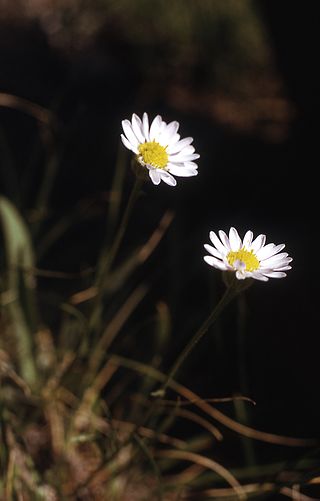
Erigeron eatonii is a North American species of flowering plants in the family Asteraceae known by the common name Eaton's fleabane.
Erigeron elegantulus is a North American species of flowering plants in the family Asteraceae known by the common names blue dwarf fleabane and volcanic daisy.

Erigeron parishii is a species of flowering plant in the family Asteraceae known by the common names Parish's daisy and Parish's fleabane.
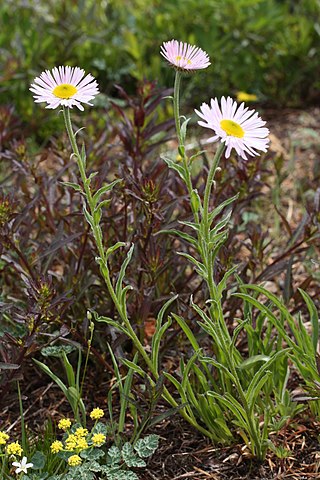
Erigeron peregrinus is a North American species of flowering plants in the family Asteraceae known by the common name wandering fleabane.
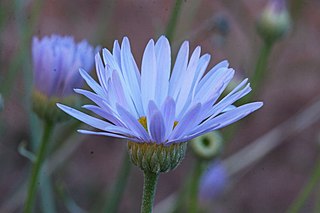
Erigeron utahensis is a North American species of flowering plant in the family Asteraceae known by the common name Utah fleabane.

Enceliopsis nudicaulis is a North American species of flowering plants in the family Asteraceae known by the common name nakedstem sunray, or naked-stemmed daisy.
Erigeron miser is a species of flowering plant in the family Asteraceae known by the common names starved daisy or starved fleabane. It is endemic to California, where it is known only from the northern High Sierra Nevada.
Erigeron multiceps is a species of flowering plant in the family Asteraceae known by the common names Kern River daisy and Kern River fleabane. It is endemic to California, where it is known mostly from the Kern Plateau in the southern High Sierra Nevada of eastern Tulare County. It is a perennial herb growing a hairy stem up to about 20 centimeters tall from a taproot and caudex. The base of the stem is surrounded by oblong leaves 2 to 5 centimeters long, and there are some smaller leaves along the length of the stem. The inflorescence produces hairy, glandular flower heads filled with yellow disc florets and a fringe of up to 125 thin, flat white to purple-tinged ray florets. The fruit is an achene with a pappus of bristles.

Erigeron reductus is a species of flowering plant in the family Asteraceae known by the common name lesser California rayless fleabane. It is endemic to California, from Trinity County south as far as Alameda County and El Dorado County.
Erigeron sanctarum is an uncommon species of flowering plant in the family Asteraceae known by the common names saints fleabane and saints daisy. It is endemic to California, where it is known from San Luis Obispo and Santa Barbara Counties including two of the Channel Islands.
Erigeron serpentinus is a rare species of flowering plant in the family Asteraceae known by the common names serpentine fleabane and serpentine daisy. It is endemic to Sonoma County, California, where it is known from three occurrences in and around The Cedars, in the Coast Ranges east of Salt Point and west of Healdsburg. There are an estimated 1100 individuals in existence. The Cedars is a canyon habitat with serpentine soils surrounded by non-serpentine terrain; it is home to several rare serpentine-endemic plant species. This daisy was discovered there and described to science in 1992.
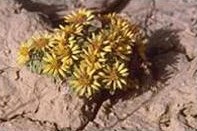
Townsendia aprica is a rare species of flowering plant in the family Asteraceae known by the common name Last Chance Townsend daisy. It is endemic to Utah in the United States, where it is known from three counties. It faces a number of threats and it is a federally listed threatened species of the United States.

Erigeron maguirei is a species of flowering plant in the family Asteraceae known by the common names Maguire daisy and Maguire's fleabane. It is endemic to Utah in the United States. It is a perennial herb growing up to 28 centimetres tall. It grows from a taproot and a branching caudex. The stems are densely hairy. The inflorescence holds one to five flower heads each with several hairy, glandular phyllaries. The head has up to 20 white, pink-tinged, or pink ray florets 0.6 to 0.8 centimeters long, and many yellow disc florets at the center.
Erigeron hessii is a rare species of flowering plant in the family Asteraceae known by the common name Hess' fleabane. It is endemic to New Mexico in the United States, where it is known from two locations in the Mogollon Mountains. It is found only in the Gila Wilderness.
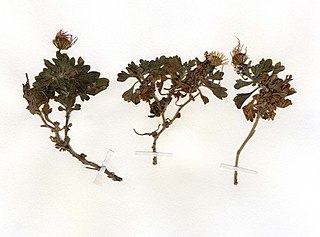
Erigeron basalticus is a species of flowering plant in the family Asteraceae known by the common names basalt fleabane and basalt daisy. It is endemic to Washington state in the United States, where it is known only from the banks of the Yakima River and its tributaries in Yakima and Kittitas Counties.

Erigeron leiomerus is a rare species of flowering plant in the family Asteraceae known by the common names rockslide yellow fleabane or rockslide fleabane. It is native to the western United States, primarily in the Rocky Mountains and the Great Basin. It has been found in Montana, Idaho, Nevada, Utah, Wyoming, Colorado, and New Mexico.














